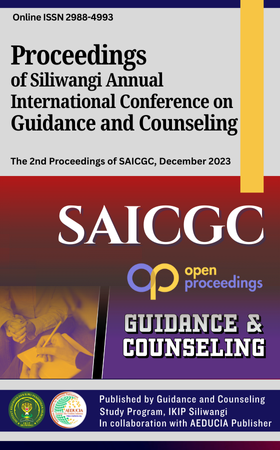The Effect of Attachments on the Psychological Well-Being of Adolescents with Divorce Parents
DOI:
https://doi.org/10.64420/saicgc.v2i1.52Keywords:
Attachment, Psychological Well-Being, Teenagers, Parental DivorceAbstract
Well-being can affect a person's mental health, this is because the positive emotions produced will make their mental condition better. The aim of this research is to determine the effect of attachment on the psychological well-being of adolescents with divorced parents. The research method used is literature study, with research subjects being teenage students with divorced parents. Based on the results of a literature review, teenagers with divorced parents tend to have low psychological well-being due to a lack of parental attachment, which causes teenagers to have insecure attachment. Insecure attachment is related to a high aspect of alienation, which is indicated by difficulty accepting oneself, difficulty accepting situations, feelings of being unwanted and unneeded, and fear of building relationships with other people. This is because they lose their main attachment figure, namely their parents. So teenagers also tend to feel sad, lonely, embarrassed, sensitive, have low self-esteem and withdraw from the environment. However, if teenagers have peer attachment, they can minimize the impact of divorce on low psychological well-being. This is because peer attachment functions as a source of psychological security for teenagers because they receive affection from their peers, apart from that it provides an experience of mutual trust and openness in communication which gives teenagers a new space to get positive affection.
References
Agustiani, H. (2006). Psikologi Perkembangan Pendekatan Ekologi Kaitannya dengan Konsep Diri. Bandung : PT. Refika Aditama
Aminah, Andayani, & Karyanta. (2012). Proses penerimaan anak (remaja akhir) terhadap perceraian orangtua dan konsekuensi psikososial yang menyertainya. Jurnal Ilmiah Psikologi Candrajiwa, 1(2).
Ainsworth, M. D. (1985). Attachment Across the Life Span. Bulletin of the New York Academy of Medicine, 61(9), 792–812.
Amato, P. R., & Booth, A. (1991). Consequences of parental divorce and marital unhappiness for adult well-being. Social forces, 69(3), 895-914. https://doi.org/10.1093/sf/69.3.895
Arboleda, D. J. D. (2022). The Quality of Sleep and Psychological Well-Being of Senior High School Students. Psychology and Education: A Multidisciplinary Journal, 1(1), 57-62. https://doi.org/10.5281/zenodo.6523128
Armsden, G., & Greenberg, M. (1987). The inventory of parent and peer attachment: Individual differences and their relationship to psychological well-being in adolescence. Journal of Youth and Adolescence, 16 (5), 427- 454. https://doi.org/10.1007/BF02202939
Arslan, N. (2017). Investigating the relationship between educational stress and emotional self-efficacy. Universal Journal of Educational Research, 5(10), 1736–1740. https://doi.org/10.13189/ujer.2017.051 010
Badan Pusat Statistik. (2022). Angka perceraian di Indonesia (2017 – 2021). https://www.bps.go.id/publication/2022/02/25/0a2afea4fab72a5d052cb315/statistik-indonesia-2022.html%20%20&%20%20https://www.bps.go.id/publication/2019/07/04/daac1ba18cae1e90706ee58a/statistik-indonesia-2019.html
Balluerka, N., Gorostiaga, A., AlonsoArbiol, I., & Aritzeta, A. (2016). Peer attachment and class emotional intelligence as predictors of adolescents' psychological well-being: A multilevel approach. Journal of adolescence, 53, 1-9.
Bowlby, J. (1969). Attachment and loss. New York: Basic Books
Bowlby, J. (1982). Attachment and loss: Vol. I. Attachment (2nd Ed.). New York: Basic Books, Inc.
Bowlby, J. (1988). Developmental psychiatry comes of age. The American journal of psychiatry. 145(1), 1–10. https://doi.org/10.1176/ajp.145.1.1
Bowlby, J. (1992). The origins of attachment theory: John bowlby and mary ainsworth. Developmental Psychology, 28(5), 759–775. https://doi.org/10.4324/9780203440841-8
Bretherton, I. (1985). Attachment theory: Retrospect and prospect. Monographs of the Society for Research in Child Development, 50(1-2), 3–35. https://doi.org/10.2307/3333824
Chandola, A. & Bhanot, S. (2008). Role of parenting style in adjustment of high school children. Journal
Dagun, S. M. (2013). Psikologi Keluarga [Family psychology]. Rineka Cipta.
Fitriani, A. (2016). Peran religiusitas dalam meningkatkan psychological well being. Al Adyan: Jurnal Studi Lintas Agama, 11(1), 57-80. https://doi.org/10.24042/ajsla.v11i1.1437
Franzoi, S., L. (2003). Social Psychology, 3rd edition. McGraw‐Hill Company.
Guarnieri, S., Ponti, L., & Tani, F. (2010). The Inventory of Parent and Peer Attachment (IPPA): A study on the validity of styles of adolescent attachment to parents and peers in an Italian sample. TPM Testing, Psychometrics, Methodology in Applied Psychology, 17(3), 103-130.
Greenberg., & Amsden. (2009). Bennett Chair of Prevention Research Director Prevention Reseach Center.
Love, K. M., & Murdock, T. B. (2004). Attachment to parents and psychological well-being: an examination of young adult college students in intact families and stepfamilies. Journal of Family Psychology, 18(4), 600-608. https://doi.org/10.1037/0893-3200.18.4.600
Lucktong, A., Salisbury, T. T., & Chamratrithirong, A. (2018). The impact of parental, peer and school attachment on the psychological well-being of early adolescents in Thailand. International Journal of Adolescence and Youth, 23(2), 235 – 249. https://doi.org/10.1080/02673843.2017.1330698
Mikulincer, M., Shaver, P. R., Cassidy, J., & Berant, E. (2009). Attachment-related defensive processes. Attachment theory and research in clinical work with adults, 293-327.
Nasri, S. A., Nisa, H., & Karjuniwati, K. (2018). Bagaimana Remaja Memaafkan Perceraian Orang Tuanya: Sebuah Studi Fenomenologis. Seurune: Jurnal Psikologi UNSYIAH, 1(2), 102–120. https://doi.org/10.24815/s-jpu.v1i2.11574
Paez Gallego, J., Gallardo López, J. A., Lopez Noguero, F., & Rodrigo Moriche, M. P. (2020). Analysis of the relationship between psychological well-being and decision making in adolescent students. Frontiers in psychology, 11, 1195. https://doi.org/10.3389/fpsyg.2020.01195
Papalia, D.E, Old, S.W, & Feldman. (2007). Human Development. New York: MC Graw Hill.
Purnama, R. A., & Wahyuni, S. (2017). Kelekatan (attachment) pada ibu dan ayah dengan kompetensi sosial pada remaja. Jurnal Psikologi, 13(1), 30-40.
Poudel, A., Gurung, B. & Khanal, G.P. (2020). Perceived social support and psychological wellbeing among Nepalese adolescents: the mediating role of self-esteem. BMC Psychology, 8(43), . https://doi.org/10.1186/s40359-020-00409-1
Puspitasari, P., Maslihah, S., & Wulandari, A. (2020). Pengaruh kelekatan terhadap kesejahteraan psikologis yang dimediasi oleh resiliensi pada remaja dengan orang tua bercerai. Jurnal Psikologi Insight, 4(1), 32-44. https://doi.org/10.17509/insight.v4i1
Rahmatia, R. (2019). Dampak perceraian pada anak usia remaja (studi pada keluarga di kecamatan wonomulyo kabupaten polewali mandar). Thesis. Makasar: Universitas Negeri Makasar.
Ramadhani, T., Djunaedi, & Sismiati, A. (2016). Kesejahteraan Psikologis (Psychological Well- Being) Siswa Yang Orangtuanya Bercerai (Studi Deskriptif yang Dilakukan pada Siswa di SMK Negeri 26 Pembangunan Jakarta). Insight: Jurnal Bimbingan Konseling, 5(1), 108–115. https://doi.org/10.21009/INSIGHT.051.16
Rosita, T., Rakhmat, C., & Soendari, T. (2020). Peran Interaksi Orangtua Pada Keterampilan Sosial Siswa Sekolah Dasar Yang Memiliki Hambatan Adhd. COLLASE (Creative of Learning Students Elementary Education), 3(3), 82-90.
Rathakrishnan, B., Sanu, M. E., Yahaya, A., Singh, S. S. B., & Kamaluddin, M. R. (2019). Emotional intelligence and psychological well-being of rural poor school students in Sabah, Malaysia. Psympathic: Jurnal Ilmiah Psikologi, 6(1), 65-72. https://doi.org/10.15575/psy.v6i1.4082
Ryff, C.D. (1989). Happiness is everything, or is it? explorations on the meaning of psychological well-being. Journal American Psychological Association, 57(6), 1069-1081. https://doi.org/10.1037/0022-3514.57.6.1069
Ryff, C. D., & Singer, B. (1996). Psychological well-being: Meaning, measurement, and implications for psychotherapy research. Psychotherapy and Psychosomatics, 65(1), 14-23. https://doi.org/10.1159/000289026.
Santrock, J. (2003). Perkembangan remaja. Jakarta : Erlangga.
Santrock, J. W. (2012). Life Span Development : Perkembangan Masa Hidup Jilid I. Jakarta: Erlangga.
Shaffer, DR. (2005). Social and Personality Development. USA: Thomson.
Snyder, C.R. & Lopez, S.J. (2002). Handbook of positive psychology. NewYork: Oxford University press.
Tomé, G., Matos, M., Simões, C., Diniz, J. A., & Camacho, I. (2012). How can peer group influence the behavior of adolescents: Explanatory model. Global Journal of Health Science, 4(2), 26–35. https://doi.org/10.5539/gjhs.v4n2p26
Troop-Gordon, W. (2017). Peer victimization in adolescence: The nature, progression, and consequences of being bullied within a developmental context. Journal of Adolescence, 55, 116–128. https://doi.org/10.1016/j.adolescence.2 016.12.012
Untari, I., Putri, K. P. D., & Hafiduddin, M. (2018). Dampak perceraian orang tua terhadap kesehatan psikologis remaja. Profesi (Profesional Islam): Media Publikasi Penelitian, 15(2), 106.
Utomo, P., & Zubaidah, Z. (2021). Kesejahteraan Psikologis Anak Autis Ditinjau dari Layanan Bimbingan dan Konseling Berkebutuhan Khusus di Sekolah. Jurnal Hawa: Studi Pengarus Utamaan Gender dan Anak, 3(1), 25–32. https://doi.org/http://dx.doi.org/10.29300/hawapsga.v3i1.5420
Vignoli, E., & Mallet, P. (2004). Validation of a brief measure of adolescents’ parent attachment based on Armsden and Greenberg’s three-dimension model. European Review of Applied Psychology, 54(4), 251-260.
Voelker, D. K., Reel, J. J., & Greenleaf, C. (2015). Weight status and body image perceptions in adolescents: Current perspectives. Adolescent Health, Medicine and Therapeutics, 6, 149– 158. https://doi.org/10.2147/AHMT.S68344
Wells, I. E. (2010). Psychology of emotions, motivations and actions: Psychological wellbeing. New York: Nova Science Publisher, Inc, 6(9), 111334.A
Downloads
Published
How to Cite
Issue
Section
License
Copyright (c) 2025 Tita Rosita

This work is licensed under a Creative Commons Attribution-ShareAlike 4.0 International License.
Authors who publish with this journal agree to the following terms: (1) Authors retain copyright and grant the journal right of first publication with the work simultaneously licensed under a Creative Commons Attribution-ShareAlike 4.0 International. that allows others to share the work with an acknowledgement of the work's authorship and initial publication in this journal; (2) Authors are able to enter into separate, additional contractual arrangements for the non-exclusive distribution of the journal's published version of the work (e.g., post it to an institutional repository or publish it in a book), with an acknowledgement of its initial publication in this journal; (3) Authors are permitted and encouraged to post their work online (e.g., in institutional repositories or on their website) prior to and during the submission process, as it can lead to productive exchanges, as well as earlier and greater citation of published work.






















